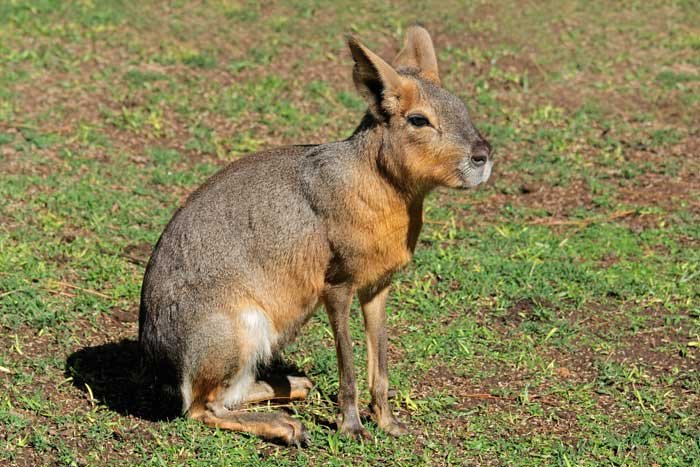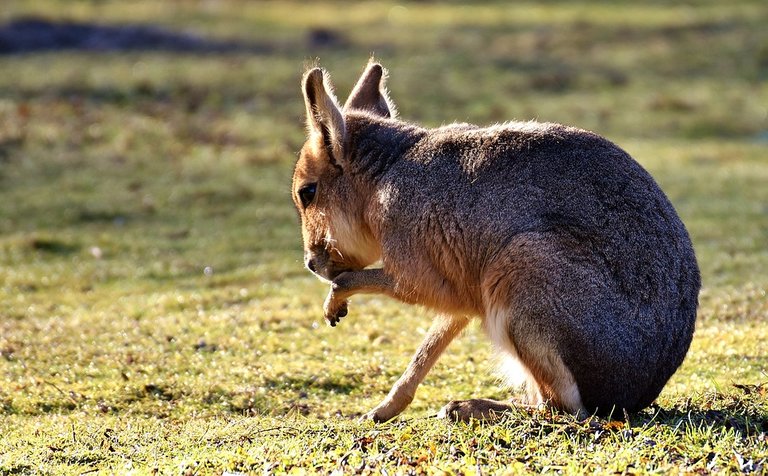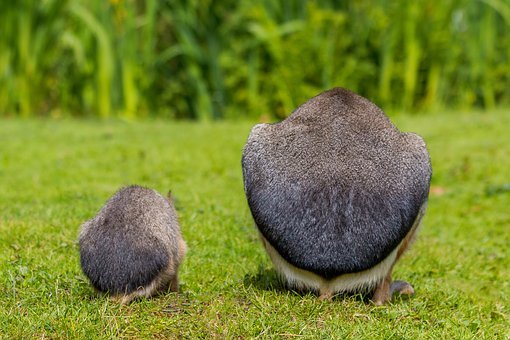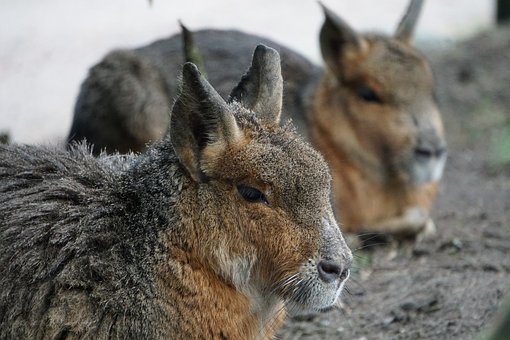The Great Pampas Grass/Pampashase
[src]
The subfamily "Pampashase" belongs to the family of guinea pigs. The relationship between our house guinea pig and the Pampas nose is not obvious. Above all, the long legs, the higher weight and overall appearance, do not really make you think of guinea pigs when you see a pampas nose. In terms of appearance, for example, the Great Pampas Grass (there is also a Small Pampas Grass) is described as sitting: the Pampas Grass is reminiscent of a hare, while standing it can be confused with a small hoofed animal.
[src] The top and bottom of the coat in the pampas grass are sharply separated from each other at the back end: white below, gray-black above. Maras have a stocky body and on the hind feet three sharp-clawed toes. At the front feet there are four toes. In terms of appearance, for example, the Great Pampas Grass (there is also a Small Pampas Grass) is described as sitting: the Pampas Grass is reminiscent of a hare, while standing it can be confused with a small hoofed animal. They look just like long-legged rabbits. The big pampa nose can reach a speed of up to 29 kilometers per hour. They can hop like rabbits, but they can also gallop or jump on all fours. They can reach a jump height of 1.8 meters.
The Great Pampas Grass is after the Capybara - the largest living rodent - the largest representative of guinea pigs. He reaches a body length of 61 to 81 centimeters (on average 71 centimeters), the tail is a stub of a maximum of 5 centimeters in length, he is flattened and almost hairless. Males reach an average weight of 7.7 kilograms, females are slightly heavier at 8.3 kilograms - the maximum weight is 16 kilograms.
Their fur is gray brown colored at the top, the belly is white. The back parts of the thighs are also white, there is also a striking, black strip above. The flanks and chin, sometimes the sides of the head are orange to rusty. The coat of these animals is dense and short, but gives a bristly impression.
[src]
The top and bottom of the coat in the pampas grass are sharply separated from each other at the back end: white below, gray-black above. Maras have a stocky body and on the hind feet three sharp-clawed toes. At the front feet there are four toes. In terms of appearance, for example, the Great Pampas Grass (there is also a Small Pampas Grass) is described as sitting: the Pampas Grass is reminiscent of a hare, while standing it can be confused with a small hoofed animal. They look just like long-legged rabbits. The big pampa nose can reach a speed of up to 29 kilometers per hour. They can hop like rabbits, but they can also gallop or jump on all fours. They can reach a jump height of 1.8 meters.
The Great Pampas Grass is after the Capybara - the largest living rodent - the largest representative of guinea pigs. He reaches a body length of 61 to 81 centimeters (on average 71 centimeters), the tail is a stub of a maximum of 5 centimeters in length, he is flattened and almost hairless. Males reach an average weight of 7.7 kilograms, females are slightly heavier at 8.3 kilograms - the maximum weight is 16 kilograms.
Their fur is gray brown colored at the top, the belly is white. The back parts of the thighs are also white, there is also a striking, black strip above. The flanks and chin, sometimes the sides of the head are orange to rusty. The coat of these animals is dense and short, but gives a bristly impression.
[src] The top and bottom of the fur are sharply separated from each other at the back end: white below, gray-black above. The small pampas nose is about 30 cm smaller than the large pampas nose, which can reach a head-trunk length of 65-81 cm and a tail length of about 5 cm. The females of the large Maras reach on average a weight of 8.3 kg, the males, however, only 7.7 kg. The maximum weight of the animals is 16 kg. Sitting, the animal is reminiscent of a rabbit, but standing up to a small hoofed animal
[src]
The top and bottom of the fur are sharply separated from each other at the back end: white below, gray-black above. The small pampas nose is about 30 cm smaller than the large pampas nose, which can reach a head-trunk length of 65-81 cm and a tail length of about 5 cm. The females of the large Maras reach on average a weight of 8.3 kg, the males, however, only 7.7 kg. The maximum weight of the animals is 16 kg. Sitting, the animal is reminiscent of a rabbit, but standing up to a small hoofed animal
[src] The pampas change their partner only when he dies. The female is mating every three to four months and only half an hour. It throws once a year what falls on the months of August to November. The Mara females can give birth to one to a maximum of five cubs; the gestation period is about 90 days. They have a lifespan of about 10 to 15 years.
[src]
The pampas change their partner only when he dies. The female is mating every three to four months and only half an hour. It throws once a year what falls on the months of August to November. The Mara females can give birth to one to a maximum of five cubs; the gestation period is about 90 days. They have a lifespan of about 10 to 15 years.
[src]
References: 1, 2, 3





Hello! I find your post valuable for the wafrica community! Thanks for the great post! @wafrica is now following you! ALWAYs follow @wafrica and use the wafrica tag!
Hello! I find your post valuable for the art community! Thanks for the great post! ARTzone is now following you! ALWAYs follow @artzone and the artzone tag, and support our artists!
You too like animals guy. I've sent your sbd. Thanks for the support.